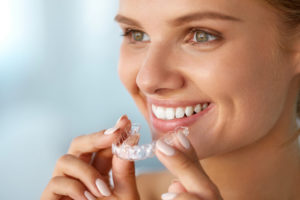 Tooth whitening involves the use of a bleaching agent to lighten the colour of the teeth. There are a variety of products on the market such as toothpastes and strips claiming to achieve tooth whitening. These products tend to have a minimal – if any – whitening effect and some can damage the teeth and gums. Only your dentist is able to assess you correctly and determine whether tooth whitening is appropriate for you. This will help ensure the best results.
Tooth whitening involves the use of a bleaching agent to lighten the colour of the teeth. There are a variety of products on the market such as toothpastes and strips claiming to achieve tooth whitening. These products tend to have a minimal – if any – whitening effect and some can damage the teeth and gums. Only your dentist is able to assess you correctly and determine whether tooth whitening is appropriate for you. This will help ensure the best results.
There are many reasons that teeth may be discoloured including surface staining (e.g. from smoking, coffee, tea, or red wine), poor oral hygiene, certain medications, tooth decay and tooth injuries. Also, as a natural part of the aging process, our teeth become darker with time.
The appearance of teeth which are discoloured as a result of poor oral hygiene can usually be improved by professional cleaning, combined with good oral hygiene practices at home. Teeth discoloured by surface stains or age usually respond best to whitening.
There are various professional whitening treatments available. We use dentist-supplied at-home whitening as this has been shown to produce less sensitivity and have a longer lasting effect than the alternatives.
Before whitening, your dentist will undertake a thorough examination of the teeth and gums. Active gum disease, tooth decay, or broken fillings will require treatment prior to whitening. Once the teeth are ready for whitening, moulds will be taken of your teeth in order to make custom-fit trays resembling thin plastic mouthguards. Your dentist will show you how to load these trays with the whitening agent and give you instructions on at-home use.
 “Whitening sessions” at home should last about an hour, with results usually becoming apparent after a couple of weeks. Every patient is different, and some will find the teeth are sufficiently whitened after only a couple of sessions. Others may require several months of whitening to achieve the desired effect. The teeth may become sensitive, in which case it is recommended to take a break from whitening until the sensitivity has subsided. Most patients find that once they reach the shade they are happy with, all that is required to maintain this shade is a few whitening sessions at home each year.
“Whitening sessions” at home should last about an hour, with results usually becoming apparent after a couple of weeks. Every patient is different, and some will find the teeth are sufficiently whitened after only a couple of sessions. Others may require several months of whitening to achieve the desired effect. The teeth may become sensitive, in which case it is recommended to take a break from whitening until the sensitivity has subsided. Most patients find that once they reach the shade they are happy with, all that is required to maintain this shade is a few whitening sessions at home each year.
It is important to note that tooth whitening will not change the colour of fillings, and may not be as effective in removing discolouration when there is deep discolouration, for example from medications. In these cases, other treatments may be required to mask discolouration, for example bonding, porcelain veneers or crowns. Sometimes a combination of cosmetic treatments is most appropriate in improving the appearance of your smile.